A New Approach to Temperature Monitoring in a Changing Clinical Supply Chain Environment
Applied Clinical Trials
Examining the implications of shipping temperature-sensitive clinical supplies in an evolving clinical supply chain, including shipments direct to patient homes (DTP) and the need for temperature monitoring thereof.
The clinical supply chain of investigational medicinal products (IMPs) is complex. The time from designing and packaging a kit through to it reaching the patient can take several months, and as well as the sponsor, involves many stakeholders such as contract manufacturing organizations (CMOs), distribution centers, logistics service providers (LSPs), and clinical sites. The clinical supply chain frequently includes different countries, several transportation legs, and many days and months with a product sitting on a shelf in different storage locations. Thus, management of the temperature exposure of a sensitive IMP is critical. Temperature deviations can put patients’ health at risk, as well as their participation in the study due to non-availability of kits. Following a temperature excursion, kits would be quarantined until the viability is determined, which could result in their destruction if they were deemed unfit for use. An IMP supply chain where the temperature control is robust is, therefore, a vital asset.
New trends are changing the clinical supply chain
Increasingly, we are seeing clinical trials that involve individualized/personalized medicines, such as gene therapies. These trials require a totally different clinical supply chain by the nature of the products and therapy areas. Speed to the patient is crucial. Additionally, in an increasingly competitive world and with spiralling development costs, there is more time pressure shortening the time for patient recruitment. Clinicians and sponsors need to consider: How can we get patients on board faster? However, it is not just about getting the patients into the studies; there is a need to improve patient retention; how can clinicians keep patients in the study, in particular for lengthy studies? Moreover, how can we increase convenience for the patients?
In recent years, the “patient’s voice” with respect to clinical trials is increasingly being heard; they are requesting more convenience, more “virtual communication” (fewer site visits, more electronic communication), and less traveling. With patient recruitment and, increasingly, retention being a concern, many sponsor companies actively involve patient groups in various clinical trial design aspects. Additionally, in support of convenience, global patient surveys1 have indicated that patients would value the delivery of IMPs to their home. Therefore, we see an increasing need and benefit for delivering IMPs direct to patient (DTP).
This increasing trend of DTP intensifies the challenge of managing the complete clinical supply chain:

- The LSP or courier may not always be aware that they are carrying pharmaceuticals; so how can we be sure that the IMP has not been exposed to temperatures outside of its range and, thus, confirm the viability of the product. How can the status be documented?
- The patient should be aware of the storage conditions of the product via information provided by the sponsor and site teams. However, how can we expect the patients to review the temperature when it is delivered directly to them?
- Once delivered, how can patients monitor temperature efficiently while storing the IMP at home, if required? When they finally use the IMP, how can they decide at the point of administration, if it is still safe to use, if it is a temperature-sensitive product?
Why monitor temperatures?
Biological and chemical medicinal products are in many cases, by definition, temperature sensitive. There are 40-plus good distribution practice (GDP) regulatory directives around the world, most recently the European Commission’s Guidelines GDP (2013/C 343/01), state requirements for maintaining product integrity throughout the lifecycle of an IMP using electronic temperature recording devices. Although using a summation of the total time out of range is not part of these regulations, there are other industry groups, namely the Parenteral Drug Association (PDA), that outlined in its Technical Report 53 how using a “stability budget” can provide visibility into maintaining proper temperatures in end-to-end clinical supply chains.
In the past, good manufacturing practice (GMP) and good clinical practice (GCP) responsibilities have typically stopped at the clinical site, when the IMP was handed over to the patient. Transportation to the patient’s home, known as the “last mile,” was never monitored. Neither was the storage at the patient’s home, since the consensus has always been “you cannot manage the patient.” ICH E6 (R2) 5.13.3 states that “the investigational product(s) should be packaged to prevent contamination and unacceptable deterioration during transport and storage.” However, this never was interpreted to include storage at the patient’s home.
With an increase in DTP deliveries, the scope of GMP and GCP could shift toward temperature monitoring by the couriers and the patient. Therefore, anything that gives the patient a clear “OK” or "Not OK" will support compliance and help ensure patient safety.
What is a stability budget?
The “stability budget” defines ideal transport and storage conditions and a budget of acceptable excursion hours above and/or below the “ideal” before a product loses stability. This stability budget has been established over time by the product innovator company through numerous stability studies, combining relevant information from temperature studies with available data from the stability testing, to determine the amount of time a product can spend out of its labeled storage conditions without risk to its safety, quality, or efficacy. As a product moves through the various phases of clinical supply chain and lifecycle, parts of this budget may be used-up by small temperature deviations-typically during loading, unloading, and transit points, from one step to the next, but also during packaging, manufacturing, or storage, small temperature deviations may happen.
Such deviations along a clinical supply chain are often called “(total) time out of storage (conditions),” or TOS. If the TOS is deducted from the original stability budget, we can calculate the remaining stability budget (RSB). If at the end of a clinical supply chain there is RSB, an IMP is safe to use, at least from a temperature perspective. If there is no RSB, it cannot be dispensed or used. When handing over an IMP to a patient, the healthcare professional must be assured that there is enough RSB to dispense it to the patient. To allow dispensing and hand-over to patient, a minimum RSB should be defined by the sponsor. Current practices do not provide this level of detail to clinical sites, but if it were available could also help in decision-making in real-time if a small temperature excursion has occurred at the site and patients are waiting.

1. The recent report on the ISPE Project Concerning Patient perceptions of IMPs found that 75% of patients would find it helpful to have their clinical trial medication delivered to their homes.
Options of clinical supply chains of IMPs
When supplying IMP's to patients, there are various different ways to define the clinical supply chain.
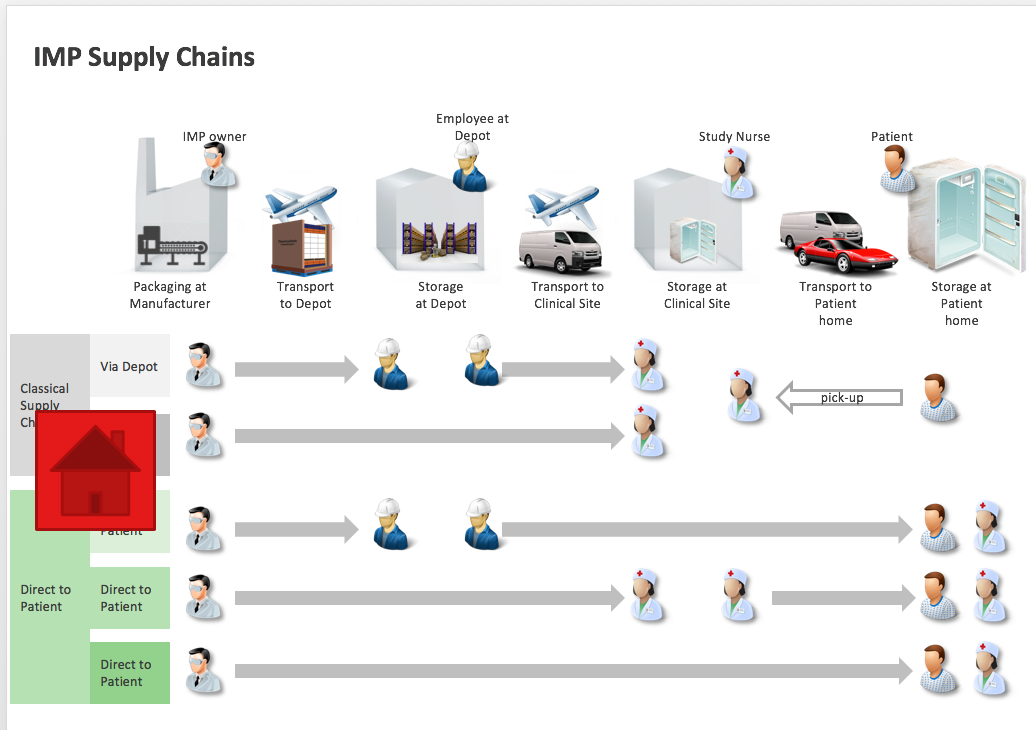
There are some questions we need to examine and answer about clinical supply chains:
- What are the reasons for different classical clinical supply chains (why via depot, why direct to site?)
- What are the reasons for DTP shipments?
The design of an appropriate clinical supply chain has to take many factors into account, not least the location and number of countries, number of clinical sites, amount of available product, and its shelf life. Sponsor companies may use CMOs to support them, as they lack the appropriate manufacturing or packaging capability/expertise or resources. In addition, in order to facilitate the logistics aspects, the sponsor or CMO may also have to consider countries where regional or local depots may be required to accommodate import requirements, and to ensure the IMP reaches the clinical site promptly and efficiently without the need to manufacture large quantities of overage.
In the clinical trials marketplace, there is increasing pressure to complete studies in a shortened timeframe to optimize “time to market.” Although the regulatory landscape is still developing in this area, various factors have resulted in many studies that include an option to ship the IMP DTP. The increasing global spread-with several studies being undertaken in a growing proportion of third-world countries, or other in areas of the globe where patients may need to travel long distances to reach the clinical site-is also driving this demand. Additionally, in the developed world, patients are requesting “choice” and can often be time-poor; visiting a clinical site just to receive medication with no study investigations is not something they wish to agree to. The increasing involvement of orphan drugs or customized medicines, coupled with the role of technology and home care, is also playing a part. Some clinical trials have been conducted remotely, or involve the use of study nurses visiting patients’ homes for drug administration or assessment purposes.
However, this patient-centric approach is not without its challenges.
The temperature monitoring challenge
Regardless of which design option is chosen for the clinical supply chain, the challenge of keeping a managed cold chain and/or to continually updating the time out of storage conditions (TOS) remains the same. DTP is emphasizing some of the challenges for the last mile.

1. Packaging must comply with GMP requirements and should never be stored outside label conditions. However, as part of a well-documented risk-based approach, a manufacturer may expose IMP outside label condition during packaging for a limited period. Thus, while packaging clinical kits (which may be partially performed temperature environment), time must be taken into consideration in the RSB.
2. Storage at depot must comply with GMP and GDP requirements. If a temperature deviation happens at a depot or in transit to the depot, how is this time taken into consideration in the remaining stability budget of each single clinical kit affected?
3. During transportation to and storage at a clinical (or investigational) site, how is temperature monitored? Are temperature deviations taken into consideration in the RSB of each single clinical kit affected? How are you ensuring the viability of the product when you hand it over to the patient and how is this documented?
4. During transportation to the patient (regardless if performed by an LSP or the patient), is temperature monitored at all? Has this been risk-assessed? Was this risk assessment included in the application to conduct the trial?
5. During storage in the patient's home refrigerator, is temperature monitored at all? Has this been risk-assessed?
6. At the very end of the clinical supply chain, before using an IMP, how does the individual know that the IMP is still safe to use? In case of ALARM, who should they contact? How will the sponsor be informed?
It is difficult in “classical” IMP clinical supply chain to keep track of the RSB. The more hand-over points, the more risks and the more complexity; it gets increasingly difficult to keep track of the temperature excursions and the RSB. Today, this is often performed manually on a paper or an Excel basis: file a batch record, deduct planned temperature excursions, and document unplanned excursions. However, once a batch gets split up throughout the clinical supply chain, this manual process is not only time-consuming and expensive-it is a process that is very fragile, error-prone, and puts quality at risk.
This is one benefit DTP offers, as it may reduce the hand-over points when shipped directly from the depot to the patient, or the transportation to the patient's home is performed by a professional and trained person, taking care of defined transportation conditions and risk assessing the processes.
Consideration of the General Data Protection Regulation 2016/679 (GDPR) and the Health Insurance Portability and Accountability Act (HIPAA) should be included in the review of the feasibility, as the DTP supply will necessitate knowledge of the patient’s name and address. How can this be undertaken within the scope of the current legislation and the GCP requirements? The informed consent must contain information on who will have access to the patient’s identifiable information (e.g., the couriers, healthcare professionals [HCPs]).
Impact of DTP on temperature monitoring challenge
What is special about shipping, handing over, storing, and documenting temperature sensitive IMP to/at patients' homes?
The typical shipment size of DTP shipments is small (e.g., usually a single or at most a handful clinical kits) compared to site or depot shipments in the clinical supply chain (e.g., several kits at one time shipped using some form of refrigerated container/cool box or even palletized delivery of multiple cool boxes). Effective data loggers typically used to monitor IMP shipments are built for these larger shipments and are not designed to monitor individual kits.
How is the IMP getting to the patient? Will the study nurse pick up the IMP at the site and bring it to the patient? Will the patient pick up the IMP at a nearby pharmacy? Or will the IMP be delivered to the patient with a courier/logistics provider (and when the study nurse arrives at the patient's home, the IMP is already there)?
When a shipment is handed over to the patient at their homes with some kind of a temperature logger, the temperature status (including the RSB) needs to be documented. The responsibility and process for recording the status of the product on dispatch to and arrival at the patient’s home needs to be clearly documented and ideally the “delivery agent” would be trained in these processes. This step should not be entrusted to patients themselves, as most will not have the equipment, training, or knowledge on temperature-sensitive shipments. In addition, for some incapacitated patients, they may lack the ability to read classical temperature data loggers or upload information to a database. In the case where an HCP is also involved in the patient's homecare, the patient may be asked to keep the package containing the IMP until that visit.
Ideally, the HCP has a tool which is intuitive and simple to use. This tool should allow them to document that the IMP is safe to use, and still has RSB before handing it over to the patient. Reading a min/max thermometer from a patient's fridge could be an option, but this would not confirm, for example, that the patient has always kept the IMP inside the fridge. It will be important that whoever is involved in the administration of the IMP has a process for reporting to the sponsorin cases where there is no RSB. Additionally, there would need to be a process for receiving urgent resupply to treat the patient in this scenario.
In today’s electronic world, interactive response technology (IRT) plays a key role in managing and monitoring many aspects of the clinical trial process, including the location, availability, and status of IMP. Can the IRT be used to monitor DTP supplies? How would it be kept up to date? Is the patient motivated and capable of doing this?
Two monitoring options
Monitoring temperatures along the clinical supply chain of an IMP up to the patient (and even during storage at the patient’s home) is important but challenging. There are two fundamentally different options to monitor and keep track of the remaining stability budget: "Measure and Puzzle" vs. lifetime/kit-level indicator.
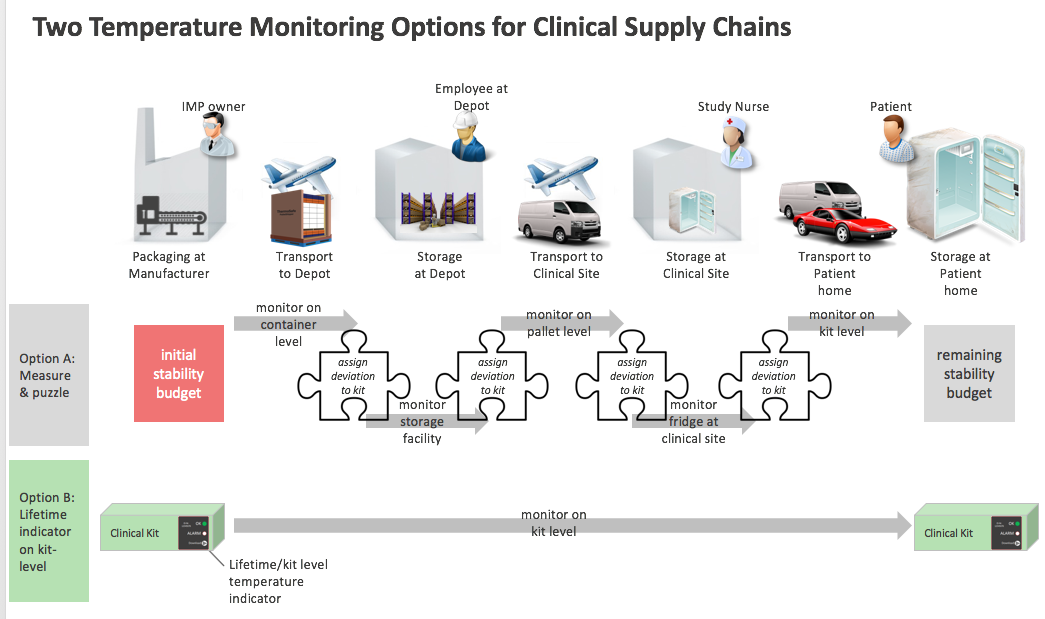
"Measure and Puzzle": Option A is what most companies are doing today-at least partly. Depending on the study and depending on the agreements with CRO/CMO, the responsibility of temperature monitoring can be organized in different ways. Depot shipments, but also site shipments, are typically monitored with temperature data loggers-at least to the point where an IMP is handed over at the clinical site or to a patient. However, the challenge with this option is how to put the puzzle pieces together.
Assume that a large quantity of clinical trial kits are shipped in several large containers to a depot. One of these containers experienced a temperature deviation during the shipment. After being repacked and combined with other IMPs, one of the kits experienced another deviation in a later clinical supply chain step, when shipped to the clinical site. How can the two deviations be combined? Even if the data loggers from the two shipments are from the same manufacturer, how difficult is it to access the information of which kit has been in which container? Are the two files stored in the same system? Today, sponsors often have to put the “puzzle pieces” together with paperwork or Excel sheets.
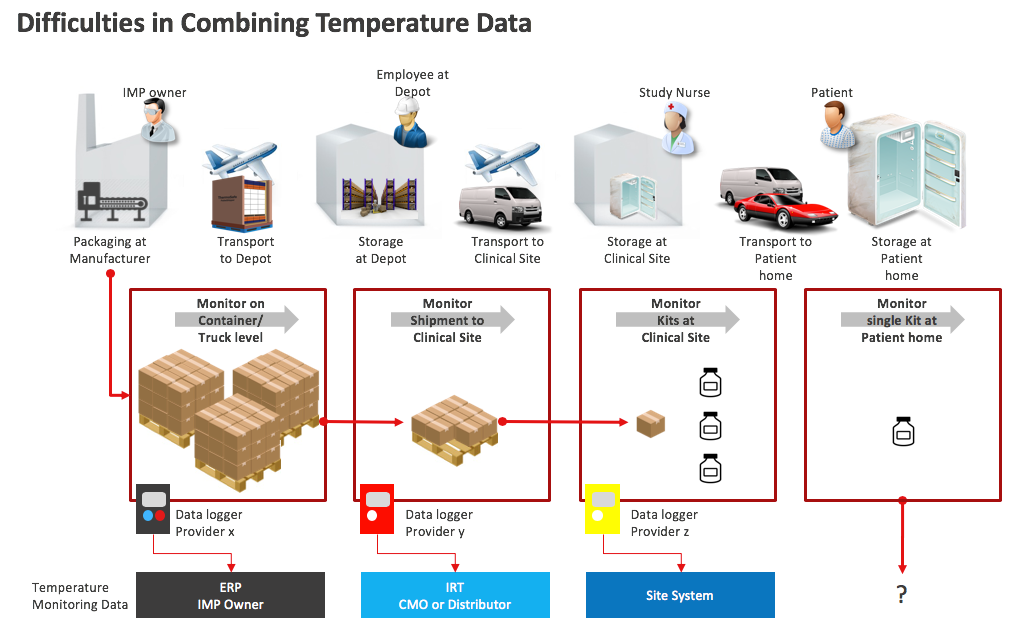
A lifetime/kit-level indicator (Option B) is a fundamentally different approach. It equips each clinical kit with an individual visual temperature indicator at a kit level and monitors temperature during the entire lifetime, from packaging/labeling to patients’ homes and final use. It is, therefore, the obvious choice for several clinical trial scenarios, including DTP shipments, since the transport to the patient-as well as the storage at the patient's home-can be monitored without interruption.
Requirements for kit-level indicators
Monitoring temperatures at a kit-level is not new. Chemical indicators, which are applied to box level, have been available for more than 20 years. However, they are typically not precise enough for IMPs and are difficult to validate-therefore, not considered GxP-compliant.
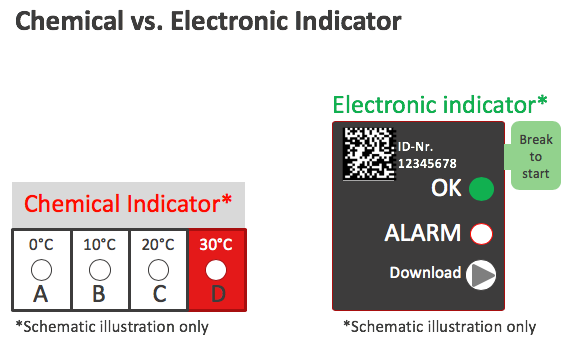
What are the requirements for an electronic kit-level indicator?
- Must be developed and produced according to GAMP5® guideline2 and equipped with a unique ID number to allow traceability.
- Must be low-cost, since tens of thousands of kits may need to be equipped (e.g. <<5 USD).
- Must be thin (<3mm) and small enough for use at the kit level (< credit card size).
- Can be attached directly to kit with self-adhesive back.
- Monitoring can be started easily without equipment.
- Has enough battery capacity to cover the entire lifetime of a typical kit (up to four years).
- Has a calibrated and accurate temperature sensor (with a NIST-traceablle3 calibration certificate).
- Can continuously monitor temperature and keep track of remaining stability budget.
- Can easily show status visually (OK to use?) at any time without additional equipment and is also intuitive to use for HCPs and the patient.
- Can document and archive the status in compliant way (no manipulation possible) and allows for easy feedback to sponsor in case the stability budget is used-up (ALARM).
- Keeps track of statistics (time per temperature zone, highest and lowest value) as well as date and time of ALARM for further analysis by the sponsor.
To bring all these requirements into one device is not an easy task, in particular since there are conflicting requirements (e.g., extreme long lifetime vs. small and thin). The ultimate dream would be to have everything in a printed label (printed electronics). Unfortunately, this is not possible today since, for example, printed batteries only deliver enough energy for a few days, not a few years. However, there are solutions on the market today, which cover all those requirements. From a monitoring perspective, such a device could simplify the management of standard clinical supply chains as well as DTP shipments, as these devices fully support patient safety.
Role of IRT
IRT systems ensure randomization and drug management functions for investigational sites. These systems typically know the status of all clinical kits through the entire clinical supply chain. If a kit is damaged or loses its complete stability budget (= has a temperature ALARM), the status of the kit in the system is changed. Using IRT systems for DTP shipments adds potential difficulties as well as opportunities:
- If no professional personnel are available, shipment and hand-over process to the patient must be simple, easy, and must be supported by IRT.
- Status of clinical kits must be reported back to the sponsor.
- IRT allows information about the status of the kit to be available at the point of hand-over to the patient (scanning the kit and transferring the data into the system), thus it increases patient safety, as it is documented that the kit was within specification when handed over to the patient. Additionally, action can be taken when this is not the case (e.g., trigger another shipment, don't hand out the IMP).
- When the kit is returned, it could be scanned and checked if there was a TOS during storage and usage at the patient’s home. Depending on the patient and the storage, it might not be possible to store used kits in refrigerated conditions and to transport them back. This would be revealed as early as possible. The scan and data transfer could be performed by the courier or when received by the depot.
- The patient could be asked to scan the kit before starting to take the medication, through a specific smartphone application, thus informing the system and enabling notifications as described above, including telling them to stop taking this kit and providing a replacement (automatically through the IRT). This could also enable better patient compliance calculations about when the patient has started to take/use an IMP kit.
- It is possible to scan all kits when the DTP shipment is dispatched, to ensure the shipped kits had no temperature excursion that might not be known yet and provide replacements when required. This will increase patient safety and, as the shipments are relatively small, this should be possible and will act as an additional QC step.
- The smartphone app could be used as an extended device to communicate with the patient like an electronic patient-reported outcome (ePRO)4 device, informing patients that a shipment was triggered for them, etc.
2. GAMP5® is a well-known development and production guideline for suppliers to the pharmaceutical industry developing and producing of electronic equipment and software.
3. NIST is a well-known (U.S.) standard of calibration which is traceable to the (U.S.) national standard. Other well-known standards are DAkkS (Germany national standard), or SAS (Swiss national accreditation standard).
4. ePRO is a patient-reported outcome that is collected by electronic methods. ePRO methods are most commonly used in clinical trials, but they are also used elsewhere in healthcare. As a function of the regulatory process, a majority of ePRO questionnaires undergo the linguistic validation process (Source: Wikipedia).
Moreover, it is important to keep track of the (temperature) status in the IRT system. To make this feasible, it is imperative to link the device ID of the electronic indicator with the kit ID. As you can see from the illustration below, this could be done via scanning the data matrix during packaging, labeling, or distribution. Once this identification between device and kit is established, it is simple to update its status later in the process without administrative effort. If a download is possible using a standard smartphone app, documentation anytime and anywhere in the process would become possible, and enable additional patient safety checks and up-to-date information for the study team.
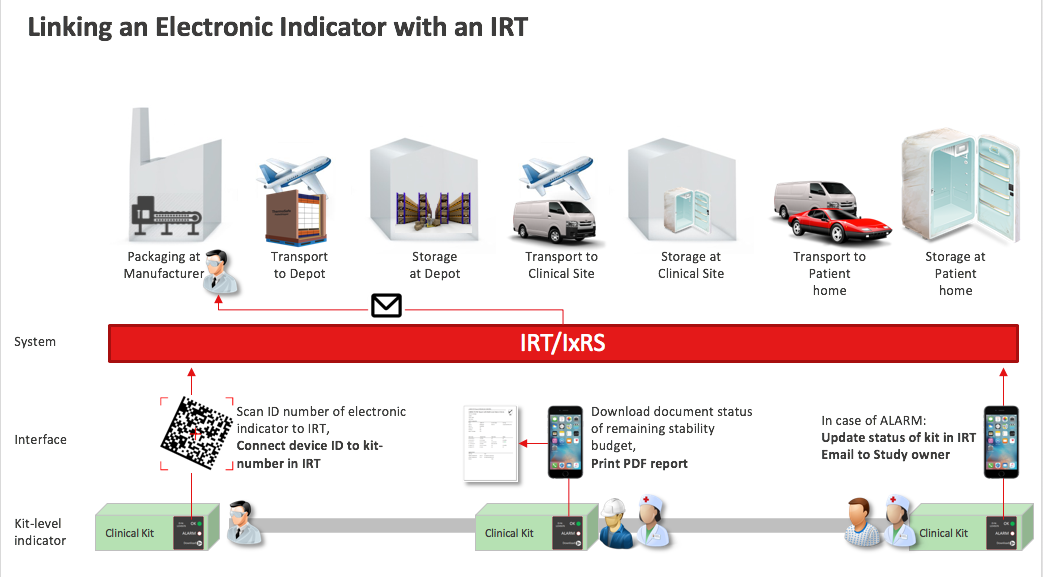
Complications
Complications that need to be considered in using a lifetime/kit level:
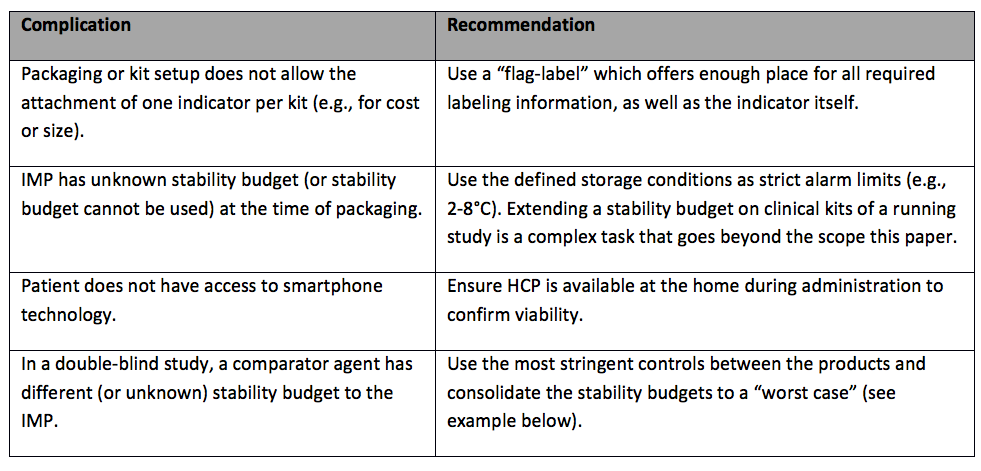
Below are examples of a “worst-case consolidation” of two stability budgets where the products are recommended to be stored at 2º- 8ºC.In the first example, we have an IMP and a comparator with the same temperature limits but just different numbers of allowed excursion hours in the range between 8° and 20°C. Defining the worst case is simple: pick the lower number of allowed excursion hours (stability budget).
In this second example, the IMP has three levels defined up to 30°C, while the comparator has fewer hours but a larger range (up to 40°C). The worst-case consolidation is to take the highest limit from the IMP (0h > 30°C), the middle range from the IMP (12h at 20° to 30°C), and take the smaller amount of hours from the comparator in the lower range (36h at 8° to 20°C).
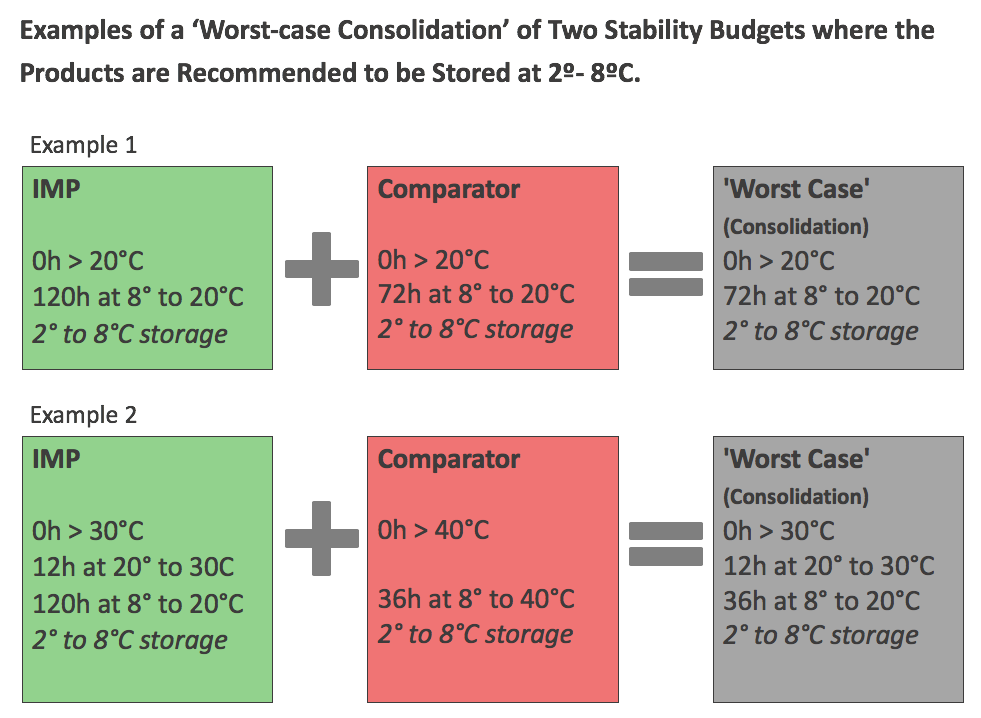
Summary
In past years, the industry has brought the processes of temperature-controlled bulk shipments close to perfection, with sophisticated data loggers and validated shipping containers. In this age where patients are much more aware of trials and where we need to go further for patients, we need to think about new ways of bringing IMP to the patient. Patients are much more technologically aware, which allows the use of modern technologies to facilitate a DTP supply.
The clinical supply chain is long and complex, with DTP adding new challenges but also new opportunities for sponsors, sites, and patients. Technologies are available to overcome those challenges and make the benefits accessible-in temperature monitoring, mobile applications, and in IRTs. However, intuitive tools, clear SOPs, and training are needed to make the processes safe, efficient, and as simple as possible for the users.
Esther Sadler-Williams is Managing Director at SimplyESW; Nimer Yusef is CEO at Trial Brain; Gary Cunnington is Global Head of Business Consultancy at the Clinical Trial Supply Unit of Boehringer Ingelheim; Samantha Carmichael is Lead Pharmacist, R&D/Clinical Trials, at NHS Greater Glasgow and Clyde; Rebecca Stanbrook is Global Head, Compliance and Regulatory Affairs Quality, at Novartis Pharma AG; Martin Peter is Executive Vice President, Strategy and Marketing, ELPRO
References
1. “Establishing and Managing the Drug Product Stability Budget,” by Erik J. van Asselt, PhD, Rafik H. Bishara, PhD.Pharmaceutical Outsourcing. Published online July 31, 2015,
http://www.pharmoutsourcing.com/Featured-Articles/178206-Establishing-and-Managing-the-Drug-Product-Stability-Budget/
2. “Establishing and managing processes enabling delivery and returns of Investigational medicinal products (IMPs) to patient's homes,” by Massimo Eli, Catherine Hall, Marianne Oth, PhD, Adrian Peskett, and Esther Sadler-Williams. Pharmaceutical Engineering. Nov/Dec 2014, 34(6). https://www.ispe.gr.jp/ISPE/07_public/pdf/201512_en.pdf
3. “Moving Toward Direct-to-Patient Models,” by Agnes Shanley. Biopharm International. Nov. 2017, 30(11): 48-51. http://www.biopharminternational.com/moving-toward-direct-patient-models-0
4. “The Growth of Direct-to-Patient Trials,” by Michael Sweeney, Stuart Redding. Applied Clinical Trials. Oct. 2016, 25(10). http://www.appliedclinicaltrialsonline.com/growth-direct-patient-trials
5. “Patient perceptions of IMPs: an international perspective,” by Esther Sadler-Williams, Lynn Wang, Samantha Carmichael, and Paula McSkimming. Pharmaceutical Engineering. May/June 2016, 36(3): 50-58. https://ispe.org/pharmaceutical-engineering
Improving Relationships and Diversifying the Site Selection Process
April 17th 2025In this episode of the Applied Clinical Trials Podcast, Liz Beatty, co-founder and chief strategy officer, Inato, discusses a number of topics around site engagement including community-based sites, the role of technology in improving site/sponsor relationships, how increased operational costs are impacting the industry, and more.
Behind the Buzz: Why Clinical Research Leaders Flock to SCOPE Summit
February 7th 2025In this episode, we meet with Micah Lieberman, Executive Conference Director for SCOPE Summit (Summit for Clinical Ops Executives) at Cambridge Innovation Institute. We will dive deep into the critical role of collaboration within the clinical research ecosystem. How do we bring together diverse stakeholders—sponsors, CROs, clinical trial tech innovators, suppliers, patients, sites, advocacy organizations, investors, and non-profits—to share best practices in trial design, program planning, innovation, and clinical operations? We’ll explore why it’s vital for thought leaders to step beyond their own organizations and learn from others, exchanging ideas that drive advancements in clinical research. Additionally, we’ll discuss the pivotal role of scientific conferences like SCOPE Summit in fostering these essential connections and collaborations, helping shape the future of clinical trials. Join us as we uncover how collective wisdom and cross-industry partnerships are transforming the landscape of clinical research.
FDA-Approved Gene Therapy Beqvez Shows Sustained Efficacy, Safety in Long-Term Hemophilia B Trial
April 17th 2025Beqvez (fidanacogene elaparvovec), an FDA-approved one-time gene therapy for hemophilia B, demonstrated sustained factor IX expression, low bleeding rates, and a favorable safety profile over long-term follow-up.